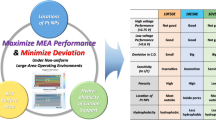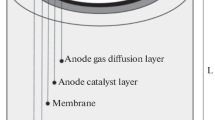Abstract
A computational framework for fuel cell analysis and optimization is presented as an innovative alternative to the time consuming trial-and-error process currently used for fuel cell design. The framework is based on a two-dimensional through-the-channel isothermal, isobaric and single phase membrane electrode assembly (MEA) model. The model input parameters are the manufacturing parameters used to build the MEA: platinum loading, platinum to carbon ratio, electrolyte content and gas diffusion layer porosity. The governing equations of the fuel cell model are solved using Netwon’s algorithm and an adaptive finite element method in order to achieve near quadratic convergence and a mesh independent solution respectively. The analysis module is used to solve the optimization problem of finding the optimal MEA composition for maximizing performance. To solve the optimization problem a gradient-based optimization algorithm is used in conjunction with analytical sensitivities. By using a gradient-based method and analytical sensitivities, the framework presented is capable of solving a complete MEA optimization problem with state-of-the-art electrode models in approximately 30 min, making it a viable alternative for solving large-scale fuel cell problems.
Similar content being viewed by others
References
Antolini E, Giorgi L, Pozio A, Passalacqua E (1999) Influence of nafion loading in the catalyst layer of gas-diffusion electrodes for pemfc. J Power Sources 77:136–142
Bangerth W, Hartmann R, Kanschat G (2008) deal.II Differential equations analysis library, technical reference. http://www.dealii.org
Bender G, Wilson MS, Zawodzinski TA (2003) Further refinements in the segmented cell approach to diagnosing performance in polymer electrolyte fuel cells. J Power Sources 123(2):163–171
Bernardi D, Verbrugge M (1991) Mathematical model of a gas diffusion electrode bonded to a polymer electrolyte. AIChE J 37(8):1151–1163
Bernardi DM, Verbrugge MW (1992) Mathematical model of the solid-polymer-electrolyte fuel cell. J Electrochem Soc 139(9):2477–2491
Berning T, Djilali N (2003) Three-dimensional computational analysis of transport phenomena in a pem fuel cell—a parametric study. J Power Sources 124(2):440–452
Berning T, Lu D, Djilali N (2002) Three-dimensional computational analysis of transport phenomena in a pem fuel cell. J Power Sources 106(1–2):284–294
Brett DJL, Atkins S, Brandon NP, Vesovic V, Vasileiadis N, Kucernak AR (2001) Measurement of the current distribution along a single flow channel of a solid polymer fuel cell. Electrochem Commun 3(11):628–632
Cacuci D (2003) Sensitivity and uncertainty analysis: theory, vol 1. Chapman and Hall/CRC, Boca Raton
Carnes B, Djilali N (2005) Systematic parameter estimation for PEM fuel cell models. J Power Sources 144(1):83–93
Chen S, Kucernak A (2004) Electrocatalysis under conditions of high mass transport rate: oxygen reduction on single submicrometer-sized pt particles supported on carbon. J Phys Chem B 108(10):3262–3276
Cheng CH, Lin HH, Lai GJ (2007) Design for geometric parameters of pem fuel cell by integrating computational fluid dynamics code with optimization method. J Power Sources 165(2):803–813
COMSOL (2005) COMSOL 3.2 Multiphysics user’s guide
Cussler EL (1997) Diffusion: mass transfer in fluid systems, 2nd edn. Cambridge University Press, Cambridge
Davis TA (2004a) Algorithm 832: Umfpack, an unsymmetric-pattern multifrontal method. ACM Trans Math Softw 30(2):196–199
Davis TA (2004b) A column pre-ordering strategy for the unsymmetric-pattern multifrontal method. ACM Trans Math Softw 30(2):165–195
E-TEK (2006) E-tek product catalogue. http://www.etek-inc.com. Accessed November 2006
Eikerling M (2006) Water management in cathode catalyst layers of pem fuel cells. J Electrochem Soc 153(3):E58–E70
Eikerling M, Kornyshev A (1998) Modelling the performance of the cathode catalyst layer of polymer electrolyte fuel cells. J Electroanal Chem 453(1–2):89–106
Eldred M, Giunta A, van Bloemen Waanders B, Wojtkiewicz SFJ, Hart W, Alleva M (2003) Dakota, a multilevel parallel object-oriented framework for design optimization, parameter estimation, uncertainty quantification, and sensitivity analysis. Version 3.0 users manual. Tech. Rep. 2001–3796, Sandia National Laboratory
Gode P, Jaouen F, Lindbergh G, Lundblad A, Sundholm G (2003) Influence of the compositon on the structure and electrochemical characteristics of the pemfc cathode. Electrochim Acta 48:4175–4187
Grujicic M, Chittajallu K (2004a) Design and optimization of polymer electrolyte membrane (PEM) fuel cells. Appl Surf Sci 227:56–72
Grujicic M, Chittajallu K (2004b) Optimization of the cathode geometry in the polymer electrolyte membrane (PEM) fuel cells. Chem Eng Sci 59:5883–5895
Grujicic M, Zhao C, Chittajallu K, Ochterbeck J (2004) Cathode and interdigitated air distributor geometry optimization in polymer electrolyte membrane (PEM) fuel cells. Mater Sci Eng B 108:241–252
Gurau V, Liu H, Kakaç S (1998) Two-dimensional model for proton exchange membrane fuel cells. AIChE J 44(11):2410–2422
Hakenjos A, Tüber K, Schumacher J, Hebling C (2004) Characterizing PEM fuel cell performance using a current distribution measurement in comparison with a CFD model. Fuel Cells 4(3):185–189
Hinatsu JT, Mizuhata M, Takenaka H (1994) Water uptake of perfluorosulfonic acid membranes for liquid water and water vapour. J Electrochem Soc 141(6):1493–1498
Hottinen T, Noponen M, Mennola T, Himanen O, Mikkola M, Lund P (2003) Effect of ambient conditions on performance and current distribution of a polymer electrolyte membrane fuel cell. J Appl Electrochem 33:265–271
Karan K (2007) Assessment of transrpot-limited catalyst utilization for engineering of ultra-low pt loading polymer electrolyte fuel cell anodes. Electrochem Commun 9(4):747–753
Kulikovsky A, Divisek J, Kornyshev A (1999) Modeling the cathode compartment of polymer electrolyte fuel cells: dead and active reaction zones. J Electrochem Soc 146(11):3981–3991
Lee S, Mukerjee S, McBreen J, Rho Y, Kho Y, Lee TH (1998) Effects of nafion impregnation on performances of pemfc electrodes. Electrochim Acta 43(24):3693–3701
Li G, Pickup PG (2003) Ionic conductivity of PEMFC electrodes. J Electrochem Soc 150(11):C745–C752
Litster S, McLean G (2004) PEM fuel cell electrodes. J Power Sources 130(1–2):61–76
Luenberger DG (1969) Optimization by vector space methods. Wiley, New York
Martins J (2002) A coupled-adjoint method for high-fidelity aero-structural optimization. Ph.D. thesis, Standford University
Martins J, Kroo I, Alonso J (2000) An automated method for sensitivity analysis using complex variables. In: 38th aerospace sciences meeting and exhibit, Reno, 10–13 January 2000
Mawardi A, Yang F, Pitchumani R (2005) Optimization of the operating parameters of a proton exchange membrane fuel cell for maximum power density. J Cell Sci Technol 2(2):121–135
Natarajan D, Nguyen TV (2004) Effect of electrode configuration and electronic conductivity on current density distribution measurements in pem fuel cells. J Power Sources 135(1):95–109
Natarajan D, Nguyen TV (2005a) Current distribution in pem fuel cells. Part 1: oxygen and fuel flow rate effects. AIChE J 51(9):2587–2598
Natarajan D, Nguyen TV (2005b) Current distribution in pem fuel cells. Part 2: air operation and temperature effect. AIChE J 51(9):2599–2608
Neyerlin KC, Gu W, Jorne J, Gasteiger HA (2006) Determination of catalyst unique parameters for the oxygen reduction reaction in a PEMFC. J Electrochem Soc 154(10):A1955–A1963
Parthasarathy A, Srinivasan S, Appleby AJ, Parthasarathy CRMA, Srinivasan S, Appleby AJ, Martin CR (1992a) Pressure dependence of the oxygen reduction reaction at the platinum microelectrode/nafion interface: electrode kinetics and mass transport. J Electrochem Soc 139(9):2530–2537
Parthasarathy A, Srinivasan S, Appleby AJ, Parthasarathy CRMA, Srinivasan S, Appleby AJ, Martin CR (1992b) Temperature dependence of the electrode kinetics of oxygen reduction at the platinum/nafion interface—a microelectrode investigation. J Electrochem Soc 139(10):2856–2862
Passalacqua E, Lufrano F, Squadrito G, Patti A, Giorgi L (2001) Nafion content in the catalyst layer of polymer electrolyte fuel cells: effects on structure and performance. Electrochim Acta 46:799–805
Sasikumar G, Ihm J, Ryu H (2004) Optimum Nafion content in PEM fuel cell electrodes. Electrochim Acta 50(2–3):601–605
Secanell M (2007) Computational modeling and optimization of proton exchange membrane fuel cells. Ph.D. thesis, University of Victoria
Secanell M, Carnes B, Suleman A, Djilali N (2007a) Numerical optimization of proton exchange membrane fuel cell cathodes. Electrochim Acta 52(7):2668–2682
Secanell M, Karan K, Suleman A, Djilali N (2007b) Multi-variable optimization of PEMFC cathodes using an agglomerate model. Electrochim Acta 52(22):6318–6337
Secanell M, Karan K, Suleman A, Djilali N (2008a) Optimal design of ultra-low platinum pemfc anode electrodes. J Electrochem Soc 155(2):B125–B134
Secanell M, Songprakorp R, Suleman A, Djilali N (2008b) Multi-objective optimization of a polymer electrolyte fuel cell membrane electrode assembly. Energy Environ Sci 1(2):378–388
Siegel N, Ellis M, Nelson D, Von Spakovsky M (2003) Single domain PEMFC model based on agglomerate catalyst geometry. J Power Sources 115(1):81–89
Sivertsen B, Djilali N (2005) Cfd based modelling of proton exchange membrane fuel cells. J Power Sources 141(1):65–78
Song D, Wang Q, Liu Z, Navessin T, Holdcroft S (2004a) Numerical study of pem fuel cell cathode with non-uniform catalyst layer. Electrochim Acta 50:731–737
Song D, Wang Q, Liu Z, Navessin T, Eikerling M, Holdcroft S (2004b) Numerical optimization study of the catalyst layer of pem fuel cell cathode. J Power Sources 126(1–2):104–111
Song D, Wang Q, Liu Z, Eikerling M, Xie Z, Navessin T, Holdcroft S (2005) A method for optimizing distributions of Nafion and Pt in cathode catalyst layers of PEM fuel cells. Electrochim Acta 50(16–17):3359–3374
Songprakorp R (2008) Investigation of dynamic behaviors of proton exchange fuel cells. Ph.D. thesis, University of Victoria
Springer T, Zawodzinski T, Gottesfeld S (1991) Polymer electrolyte fuel cell model. J Electrochem Soc 138(8):2334–2342
Stumper J, Campbell SA, Wilkinson DP, Johnson MC, Davis M (1998) In-situ methods for the determination of current distributions in pem fuel cells. Electrochim Acta 43(24):3773–3783
Sun W, Peppley BA, Karan K (2005) An improved two-dimensional agglomerate cathode model to study the influence of catalyst layer structural parameters. Electrochim Acta 50(16–17):3347–3358
Wang L, Liu H (2004) Performance studies of pem fuel cells with interdigitated flow fields. J Power Sources 134(2):185–196
Wang JX, Springer TE, Adzic RR (2006) Dual-pathway kinetic equation for the hydrogen oxidation reaction on pt electrodes. J Electrochem Soc 153(9):A1732–A1740
Wang Q, Eikerling M, Song D, Liu Z (2004a) Structure and performance of different types of agglomerates in cathode catalyst layers in PEM fuel cells. J Electroanal Chem 573:61–69
Wang Q, Eikerling M, Song D, Liu Z, Navessin T, Xie Z, Holdcroft S (2004b) Functionally graded cathode catalyst layers for polymer electrolyte fuel cells. I. Theoretical modeling. J Electrochem Soc 151(7):A950–A957
Wang L, Husar A, Zhou T, Liu H (2003) A parametric study of pem fuel cell performances. Int J Hydrogen Energy 28(11):1263–1272
Xie J, More KL, Zawodzinski TA, Smith WH (2004) Porosimetry of meas made by “thin film decal” method and its effects on performance of PEFCs. J Electrochem Soc 151(11):A1841–A1846
Xie Z, Navessin T, Shi K, Chow R, Wang Q, Song D, Andreaus B, Eikerling M, Liu Z, Holdcroft S (2005) Functionally graded cathode catalyst layers for polymer electrolyte fuel cells. II. Experimental study of the effects of nafion distribution. J Electrochem Soc 152(6):A1171–A1179
Yosida K (1965) Functional analysis. Springer, Berlin
You L, Liu H (2001) A parametric study of the cathode catalyst layer of PEM fuel cells using a pseudo-homogeneous model. Int J Hydrogen Energy 26(9):991–999
Author information
Authors and Affiliations
Corresponding author
Additional information
This article was presented at the 12th AIAA/ISSMO Multidisciplinary Analysis and Optimization Conference, Victoria, BC, Canada, Sept 10–12, 2008.
Rights and permissions
About this article
Cite this article
Secanell, M., Songprakorp, R., Djilali, N. et al. Optimization of a proton exchange membrane fuel cell membrane electrode assembly. Struct Multidisc Optim 40, 563–583 (2010). https://doi.org/10.1007/s00158-009-0387-z
Received:
Revised:
Accepted:
Published:
Issue Date:
DOI: https://doi.org/10.1007/s00158-009-0387-z




